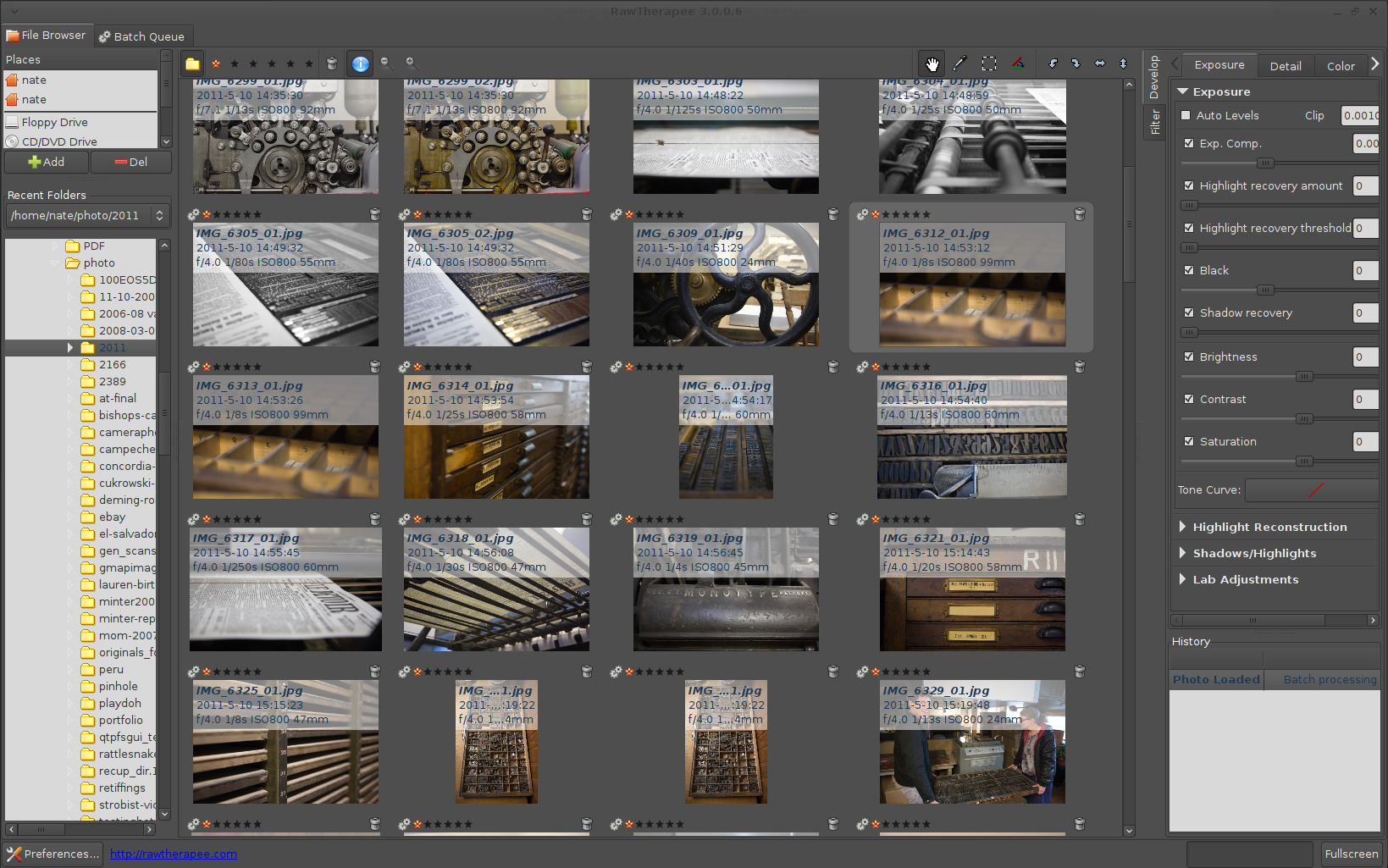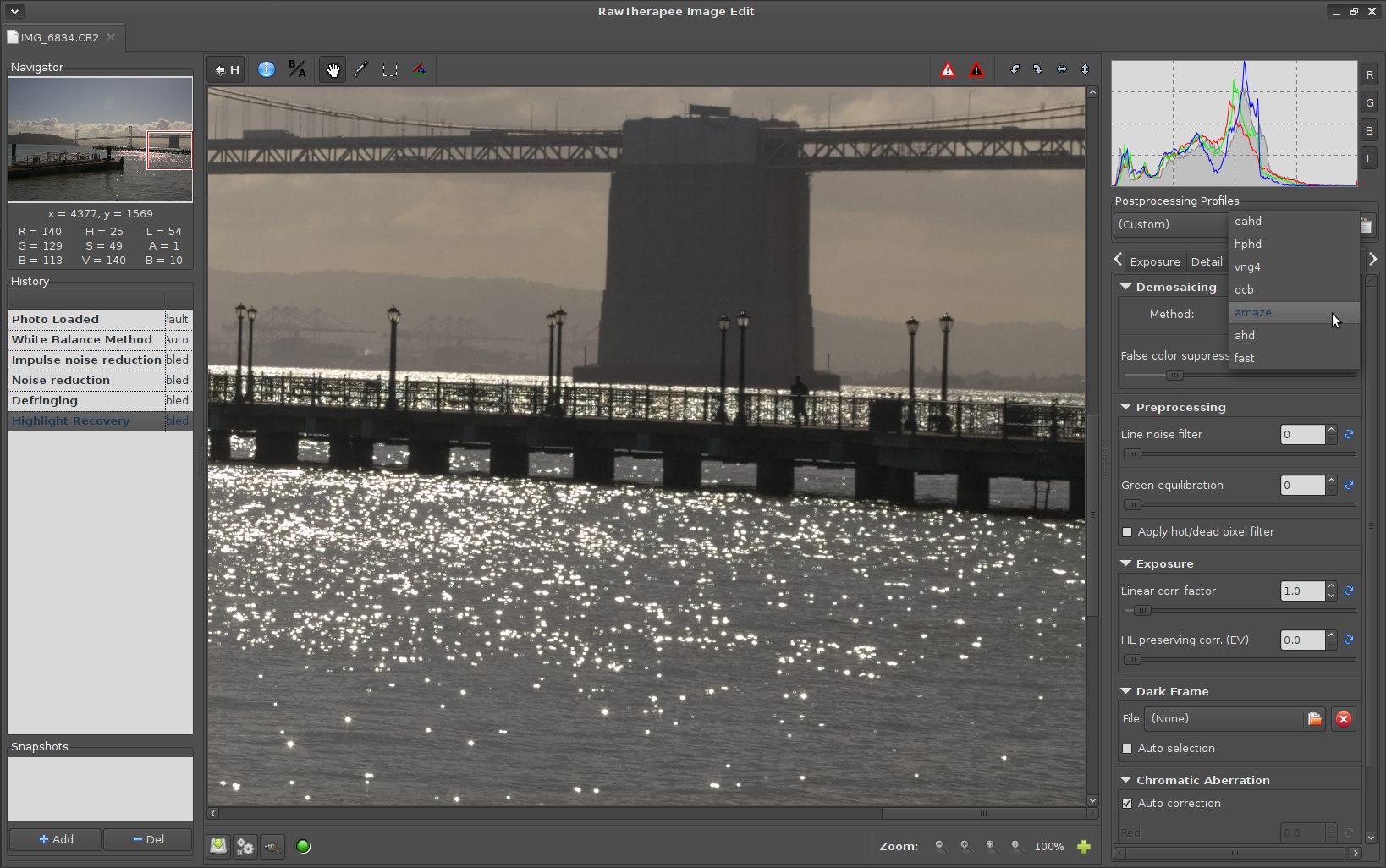The open source raw photo editor RawTherapee released version 3.0 at the end of July, with a revamped interface and a new palette of photo tools. RawTherapee is noteworthy for several reasons, including the fact that builds are available for Mac OS X and Windows, in addition to Linux. But this release also marks the first major update to the program since it was made free software. Let’s take a look.
In the two years since developer Gabor Horvath switched from a proprietary licensing system to the GPLv3, a small team of contributors has grown up around the RawTherapee code. Many are users of non-Linux OSes, which is good for the outreach side of promoting open source. On the RawTherapee downloads page, you can grab installers for Windows and Mac machines, as well as 32-bit and 64-bit versions of the application packaged for the Ubuntu and Gentoo distributions. A separate page lists build for other distros, including Fedora.
In my opinion, the wealth of download offerings listed on the page is a bit confusing, as is the “filter tool” at the top and the need to click on individual items to see their details. Even after you narrow your choices down to “stable, Linux, 32-bit” there are several identically-named (and identically-detailed) packages. Only the actual file names reveal that one package has the debug symbols turned on.
Assuming you eventually find the bundle you are interested in, it unpacks into a self-contained directory containing a standard launcher script. If it is your first time using RawTherapee, you might find it worthwhile to grab the user manual (although, frustratingly, it is only provided as a PDF file). The manual gives a good tour of the interface, but its best feature is documentation of the individual tools: what “color propagation,” “impulse noise reduction,” and “RL deconvolution” actually do is not self-explanatory even to many photographers.
Basic Usage
RawTherapee uses the same UI conventions as most other raw photo tools: file-and-directory tree down the left-hand side, image workspace in the middle, and vertical strip of adjustment tools down the right. By default, the app uses tabs to keep the images you open separate from each other; a file-browser tab (from which you can make adjustments to selected images) and a “batch queue” tab are also visible at all times.
When you open a photo, an image histogram is always visible at the top of the right-hand tool-strip (which is important; some editors place it at the bottom where it can get pushed off the bottom), and navigator marking your position on a full-frame thumbnail is visible on the top left. Where all raw editors get into trouble is trying to fit all of the adjustment tools onto the screen in that one narrow tool-strip.
 RawTherapee splits the tools into six tabs: Exposure, Detail, Color, Transform, RAW [sic], and Metadata. Apart from Metadata (which is informational only), each tab sports a list of collapsible adjustment tools. Overall, the UI does a good job of distinguishing between those that are optional (such as highlight reconstruction, which pulls additional detail out of washed-out sections of the image) and those that are not (such as white balance; you have several options for setting the image’s white balance, but every image has some white point).
RawTherapee splits the tools into six tabs: Exposure, Detail, Color, Transform, RAW [sic], and Metadata. Apart from Metadata (which is informational only), each tab sports a list of collapsible adjustment tools. Overall, the UI does a good job of distinguishing between those that are optional (such as highlight reconstruction, which pulls additional detail out of washed-out sections of the image) and those that are not (such as white balance; you have several options for setting the image’s white balance, but every image has some white point).
Generally, optional settings have a check-box that enable or disable the function, while mandatory settings have simple sliders. But there are a few stray exceptions, such as vignetting and distortion correction, which have sliders set to zero but no checkbox. My concern is that this inconsistency suggests to novices that all images have (or need) vignetting correction, when in fact they don’t. Yet the exceptions only stand out because the UI does such a good job of making it clear which tweaks are optional.
Batch mode and image export both work smoothly, and there is a one-click “fullscreen” button that gives you the maximum work area your monitor allows. Although version 3.0 also includes a feature that goes one better, enabling multi-monitor usage. The new features don’t stop there, however….
What’s New
3.0 unveils a wide range of enhancements over the previous stable release, 2.4. This is certainly not surprising, since 2.4 was essentially the same as the closed-source version Horvath developed on his own.
The new dual-monitor interface is one of the most easily-visible changes (and as far as I am aware, no other raw editor sports a similar UI approach). Basically, this mode uses one monitor for the file browser and batch queue, and the other monitor for the image-editing interface. That could be helpful if you have one substantially-better (or substantially larger) monitor than the other. But even on a normal dual-head setup, it makes better use of your real estate and alleviates the need to constantly switch tabs back-and-forth.
 On the usability front, there are also keyboard shortcuts for almost every command, automatic “collapsing” of non-focused tools to conserve space, automatic saving of the batch queue in the event of a crash, a custom “dark” UI theme, and new icons. Supposedly there are vast improvements of the look-and-feel for the Windows build, but I did not feel like purchasing a copy of Windows to test them. Finally, there is full support for non-Latin characters in file and directory names, which should come as quite a relief to most of the world.
On the usability front, there are also keyboard shortcuts for almost every command, automatic “collapsing” of non-focused tools to conserve space, automatic saving of the batch queue in the event of a crash, a custom “dark” UI theme, and new icons. Supposedly there are vast improvements of the look-and-feel for the Windows build, but I did not feel like purchasing a copy of Windows to test them. Finally, there is full support for non-Latin characters in file and directory names, which should come as quite a relief to most of the world.
When it comes to image editing, there are new tools for hue and saturation, cropping and resizing, chromatic aberration correction, highlight recovery, and “fringe” removal (which fixes colorful artifacts along very bright edges). You can also adjust the exposure of an image over a larger range and use luminance (instead of vanilla RGB values) to show black and white “clipping” effects. There are also some new automatic features, such as dead pixel correction – that is when a pixel on the camera’s sensor is “stuck” and always appears one color, such as bright red.
Last but not least, there are several improvements described in the release notes to under-the-hood routines, such as previewing adjustments, calculating auto-exposure, and loading and rendering thumbnails. Unless you happened to have a noticeably off-kilter image, you might not detect mistakes in auto-exposure calculation, but I can easily attest to the improvement in speed and quality of previews.
Quirks and the Future
For all the improvements in RawTherapee 3.0, there are still a handful of places where the app feels out-of-place, at least when compared to other Linux GUI applications, plus a few frustrating (and seemingly arbitrary) limitations.
For example, the application Preferences are accessible not through the Edit menu, but through a button in the lower-left-hand corner of the main window. The file browser uses double-clicks to navigate between folders (which is not normal for GTK+ tree-view widgets). The zoom buttons are on the top toolbar in the preview tab, but jump to the bottom toolbar when opening an image in a tab of its own.
I found it peculiar that dual-monitor mode allowed me to put the file browser tab into windowless “fullscreen” mode, but did not allow me to do the same to the (separate, in this mode) image editing tab. At a practical level, I appreciate that RawTherapee has an “open this image in an external editor” function, and that I can select which application that function launches. But it is aggravating that it only supports one external editor. Surely there is an upper limit of eight or so, but even rank amateurs would want access to at least two or three options.
Those oddities are forgivable, however. By and large, I am just happy to see the progress that RawTherapee has made. 3.0 has been a very long release cycle, in no small part due to the adjustment curve of transitioning from a solo, closed project to an open project with a public infrastructure. Horvath and the rest of the team has handled it well, and to their credit they are making improvements in the road map and release engineering areas. In fact, you can already download nightly builds of the unstable 3.1 series code.
For Linux-based photographers, RawTherapee’s strong suit is that it offers a lot of choices for image adjustment. There is fine-grained control over most functions and plenty of choice for potentially interesting options in de-mosaicing and other low-level functionality. I would still contend, however, that RawTherapee’s strongest suit is the one that goes unmentioned in most reviews: the fact that it is available for Windows and OS X users, too. Although you can do excellent photography with an all-Linux setup, the fact remains that most photographers (pro and amateur) remain on non-free OSes. RawTherapee offers them some freedom from the expensive proprietary vendors, and in the long run getting a foot in the door is good for Linux and open source in general.





